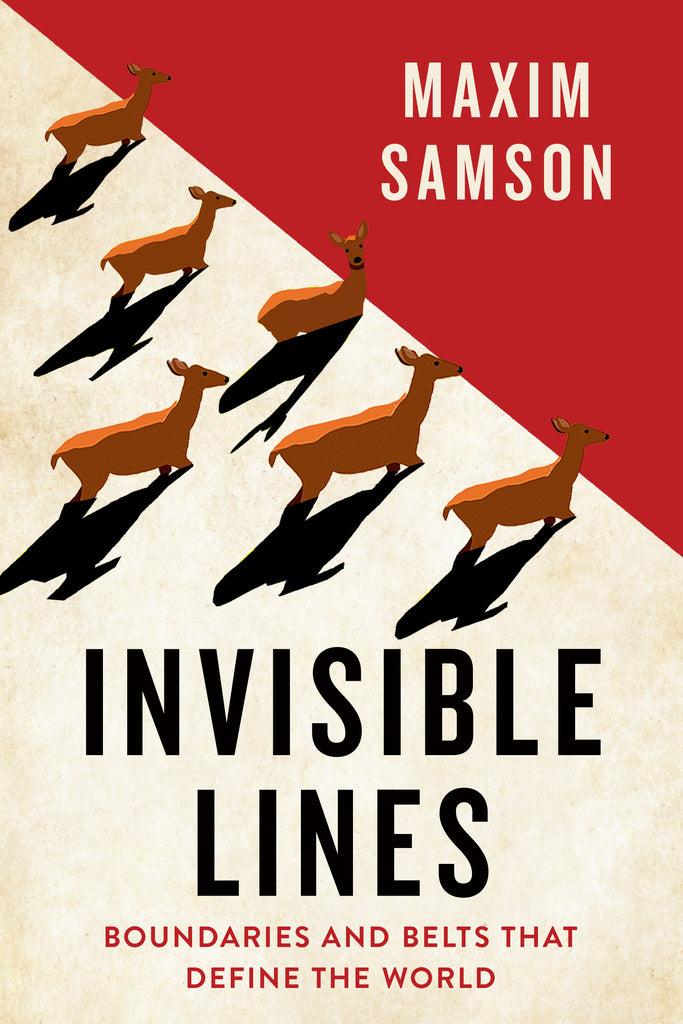An indispensable guide to seeing and understanding our planet through the divisions we make, find, or feel.
Our world has innumerable boundaries. They range from the obvious—an ocean, or a mountain range—to subtle differences in language or climate. We cross boundaries all the time, sometimes without realizing it. They can be subjective: our perceptions of a boundary may not be shared by others. And yet they shape the way we engage with the world. Geographer Maxim Samson examines invisible lines, exploring the ways in which we divide this world—from meteorology and ecology to race and religion—and how they allow us to define “insiders” and “outsiders,” to identify places where particular attention and resources are especially urgent, to distinguish between two sides, two groups, two futures. From segregation along Detroit’s infamous 8 Mile to herds of red deer that still refuse to cross the former Iron Curtain, the existence—or perceived existence—of dividing lines has manifold implications for people, wildlife, and places.
Vividly written and illustrated with maps, Invisible Lines is a compelling exploration of boundaries in all their consistency, and all their messiness too.
An indispensable guide to seeing and understanding our planet through the divisions we make, find, or feel.
Our world has innumerable boundaries. They range from the obvious—an ocean, or a mountain range—to subtle differences in language or climate. We cross boundaries all the time, sometimes without realizing it. They can be subjective: our perceptions of a boundary may not be shared by others. And yet they shape the way we engage with the world. Geographer Maxim Samson examines invisible lines, exploring the ways in which we divide this world—from meteorology and ecology to race and religion—and how they allow us to define “insiders” and “outsiders,” to identify places where particular attention and resources are especially urgent, to distinguish between two sides, two groups, two futures. From segregation along Detroit’s infamous 8 Mile to herds of red deer that still refuse to cross the former Iron Curtain, the existence—or perceived existence—of dividing lines has manifold implications for people, wildlife, and places.
Vividly written and illustrated with maps, Invisible Lines is a compelling exploration of boundaries in all their consistency, and all their messiness too.
| Published By | House of Anansi Press Inc — Feb 13, 2024 |
| Specifications | 416 pages | 6 in x 9 in |
| Keywords | trivia; globe; our planet; environment; trade; ken jennings; jeopardy; curiosity; encyclopedia; |
|
Supporting Resources
(select item to download) |
Excerpt |
| Written By |
MAXIM SAMSON is a geographer with specific interests in religion, education, and cities. Originally from England, Maxim is currently based in Chicago, where he teaches at DePaul University and chairs an international research group specializing in the geographies of religions and belief systems. In his spare time, he enjoys long-distance running, maintaining his Duolingo streak, and gradually adding to his kaleidoscopic flag collection. Invisible Lines is his first book. |
| Written By |
|
MAXIM SAMSON is a geographer with specific interests in religion, education, and cities. Originally from England, Maxim is currently based in Chicago, where he teaches at DePaul University and chairs an international research group specializing in the geographies of religions and belief systems. In his spare time, he enjoys long-distance running, maintaining his Duolingo streak, and gradually adding to his kaleidoscopic flag collection. Invisible Lines is his first book. |
An illuminating glimpse of the chain reactions of human and physical geography.
This is a chance to see the world anew through the eyes of a wonderfully curious new writer.
Intricately detailed explanation of how each invisible line came to be, as well as what it can tell us about the world and our place within it ... A fascinating read.
A fascinating, detailed exploration of the hidden boundaries that carve up the world.
Old worlds enhanced, new worlds exposed and challenged ... a wise and thought-provoking series of raids across borders we thought we knew and others made visible to us, by Maxim Samson's forensic eye, for the first time.
” —Iain Sinclair, author of The Gold Machine and The Last LondonUtterly engrossing! Samson’s literary atlas of the world’s unseen boundaries and how they’ve shaped our lives demands to be read.
” —Lewis Dartnell, author of Origins: How the Earth Shaped Human HistoryA fascinating book ... a truly original adventure into new ways of exploring what we mean by a sense of place.
” —Simon Jenkins, author of The Celts and A Short History of EnglandThe world is a mesh of lines. We don’t normally see them, and so we blunder on, unaware of where we really are and missing out on so much. Samson’s iconoclastic new geography will make the scales fall from your eyes. A tremendous and important read.
” —Charles Foster, author of Cry of the WildA journey to the unmarked and unseen borders that shape our world ... a fascinating, extraordinary, and insightful exploration of the many boundaries that define us.
” —Alastair Bonnett, author of The Age of Islands and Off the MapThis absorbing book is an accessible and wide-ranging read, built upon erudition, curiosity, and careful compilation. It reveals and reflects upon many types of divisions between places—stretching from the Antarctic to the Urals, and from the turfs of passionate soccer fans in Buenos Aires to linguisitic divisions in Brittany, to name but a few.
” —Cliff Hague OBE, Emeritus Professor of Planning and Spatial Development at Heriot-Watt University
